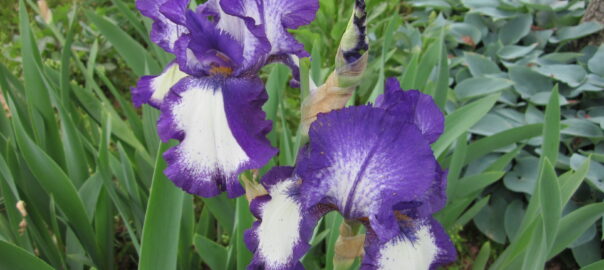
According to our local weather forecasters, this month’s many days of 90-degree-plus temperatures have resulted in “the longest June heat wave in nearly a century.” And the pollen count has been the worst we can remember. For sure, every raindrop has been welcomed with open arms.
The Japanese Dogwood (Cornus kousa) blooms have been extraordinary. It’s sad to see the browning of their star-like “petals” as they die off and float to the ground. We are told that they aren’t real flower petals, but modified leaves called “bracts” surrounding small, greenish-yellow, insignificant flowers. Little green berries are appearing in their place and by summer’s end we’ll be gifted with hundreds of pretty/plump red berries.
We’re keeping busy removing the daffodil foliage that has fully ripened, as well as the many invasive weeds that are trying to take over our world, such as goutweed (Aegopodium podagraria) and garlic mustard (Alliaria petiolata).
The former will be ours forever since it’s really a perennial that is almost impossible to get rid of. The garlic mustard is a biennial that spreads by seed, but it’s easy to pull out and throw away in the rubbish. No way would we ever add it to our compost pile.
Speaking of biennials that self-seed, the foxgloves (Digitalis purpurea) in our garden are not really a problem since they are shallow-rooted and easy to remove if they show up in a not-so ideal location. This year some of the plants are six-feet tall and full of colorful, tubular blossoms often visited by our bees and hummers.
What makes the foxgloves even more special is that as the flowers die off, the plants can be trimmed/dead-headed, and they will often bloom again into autumn. I often “rub off” the seed capsules right over the same area, where new plants may appear by the end of summer. They may be left in place or transplanted to another part of the garden. Or, the babies may be shared with our neighbors.
One major disappointment this year has been the “spreading” of our creeping phlox (Phlox subulata). Although we love their colors and the fact that they “return” every year, they have “taken over” some areas, smothering/killing neighboring plants. Of course, it’s really our fault, not keeping up/controlling it. After all, “creeping” is part of its name.
But, the highlights of our spring blossoms were the irises. Named after the Greek word for “rainbow,” they were showstoppers, for sure. We’ve been removing their spent flowers, since allowing them to form seedheads “saps their energy,” reducing next year’s blooms. Actually, the plants need regular division to remain vigorous and are best divided in late summer, at least 8 weeks after they’ve bloomed.
So, I guess I know what I’ll be doing in September!

